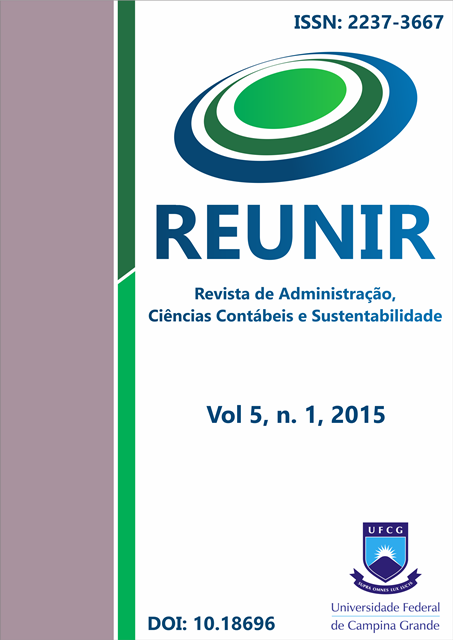BRAND FLINGS: EMOÇÕES PASSAGEIRAS COM AS MARCAS
DOI:
https://doi.org/10.18696/reunir.v5i1.291Keywords:
Relacionamento. Marcas. Brand flings.Abstract
O objetivo do presente trabalho consiste em estudar o fenômeno brand flings como um tipo de relacionamento com as marcas. Para tanto, se utiliza de entrevistas semiestruturadas em profundidade, com oito potenciais usuários de marcas de itens do vestuário, perfumes e eletroeletrônicos. A seleção da amostra considerou indivíduos com formação acadêmica completa e estabilidade profissional. As entrevistas foram todas gravadas, com tempo médio de duração de 28 minutos, cujo processo de análise de conteúdo por meio do software Atlas.ti 5.0 se valeu da narrativa das experiências vivenciadas por cada um dos indivíduos com as marcas consumidas. O estudo aponta o brand flings como um tipo de relacionamento dos consumidores com as marcas, como tratado na teoria. Dentre os atributos encontrados para esse tipo de relacionamento, destaca-se o aspecto emocional do indivíduo, que se modifica de acordo com as fases específicas da vida. Observa-se ainda, tendências determinadas pela sociedade (moda) e o estabelecimento de ciclos de excitação (positivo) e tédio (negativo) com relação à marca. O brand flings também se volta a problemas gerados em razão de experiências ruins com as marcas, ocorridas em razão da qualidade, durabilidade, tamanho, aceitação de mercado (revenda) e prestação de serviços correlatos.Downloads
References
AAKER, J., FOURNIER S.; BRASEL, S.A. When good brands do bad. Journal of Consumer Research, vol. 31, jun. 2004, pp. 01-16.
AGGARWAL, P. The Effects of Brand Relationship Norms on consumer Attitudes and Behavior. Journal of Consumer Research. vol. 31, jun. 2004, pp. 87-101.
AHLUWALIA, R.; KAIKATI, A.M. Traveling the paths to brand loyalty. In: LOKEN, B.; AHLUWALIA, R.; HOUSTON, M.J. Brands and brand management: contemporary research perspectives. Routledge: New York, 2010, pp. 63-90.
ALVAREZ, C.; FOURNIER, S. Brand flings: when great brand relationships are not made to last. In> FOURNIER, S.; BREZEALE, M.; FETSCHERIN, M. Consumer-brand relationships: theory and practice. New York: Routledge, 2012, pp. 74-96.
BARDIN, L. Análise de conteúdo. Lisboa: Edições 70, 1977.
BAUMAN, Z. Consuming Life. Journal of Consumer Culture, vol. 1, n. 1, mar. 2001, pp. 9-29.
BLACKSTON, M. Observations: building brand equity by managing the brand´s relationship. Journal of Advertising Research, vol. 40, n. 6, nov./dec. 2000, pp. 101-105.
BROWN, S. Postmodern marketing? European Journal of Marketing, vol. 27, n. 4, set./dec. 1993, pp. 19-34.
ESCALAS, J.E.; BETTMAN, J.R. Self-Construal, Reference Groups, and Brand Meaning. Journal of Consumer Research. vol. 32, dec. 2005, pp. 378-389.
FOURNIER, S. Consumers and their brands: developing relationship theory in consumer research. Journal of Consumer Research, vol. 24, n. 4, mar. 1998, pp. 343-353.
FOURNIER, S. Lessons learned about consumers’relationshoips with their brands. In: MACINNIS, D.; PARK, C.W.; PRIESTER, J.R. Handbook of brand relashionships. M.E.Sharpe: New York, 2009, pp. 5-23.
FOURNIER, S.; ALVAREZ, C. Relating badly to brands. Journal of Consumer Psychology, vol. 23, n. 2, jan. 2013, pp. 253-264.
GIFFORD JR, D. Moving beyond loyalty. Harvard Business Review, vol. 75, n. 2, mar./abr. 1997, pp. 9-10.
GIL-JUÁREZ, A. Consumption as an Emotional Social Control Device. Theory Psychology, vol. 19, n. 06, dez. 2009, pp. 837-858.
HEDING, T.; KNUDTZEN, C.F.; BJERRE, M. Brand Management: Research, theory and practice. New York: Routledge, 2009.
ILLOUZ, E. Emotions, Imagination and Consumption: A new research agenda. Journal of Consumer Culture, vol. 9, n. 3, nov. 2009, pp. 377-413.
MACIEL, C. O.; WEYMER, A. S. Q.; AUGUSTO, P. O. M. Identificando os condicionantes socialmente construídos (Enacted) das práticas estratégicas em ambientes altamente institucionalizados. Revista RAC, vol. 16, n. 1, jan./fev. 2012, pp. 79-97.
MACINNIS, D. J.; PARK, C.W.; PRIESTER, J. R. (Eds.). Handbook of brand relationships. New York: M.E. Sharpe, 2009.
MARTINS, G. A.; THEÓPHILO, C. R. Metodologia da investigação científica para as ciências sociais aplicadas. 2. ed. São Paulo: Atlas, 2009.
McCRACKEN, G. Who is the Celebrity Endorser? Cultural Foundations of the Endorsement Process. Journal of Consumer Research, vol. 16, n. 3, dec. 1989, pp. 310-321.
MILLER, F., FOURNIER, S.; ALLEN, C. Exploring relationship analogues in the brand space. In: FOURNIER, S.; BREAZEALE, M.; FETSCHERIN, M. (eds.). Consumer–brand relationships: theory and practice. New York: Routledge, 2012, pp. 30-56.
PARK, J.W; KIM, H. KIM, J. Acceptance of brand extensions: interactive influences of product category similarity, typicality of claimed benefits, and brand relationship quality. Advances in Consumer Research. Valdosta: Associations of Consumer Research, vol. 29, 2002, pp. 190-198.
ROSA, M. V. F. P. C.; ARNOLDI, M. A. G. C. A entrevista na pesquisa qualitativa: mecanismo para validação dos resultados. Belo Horizonte: Autêntica, 2006.
SMITHEE, A. Kotler is dead! European Journal of Marketing, vol. 31, n. 3-4, 1997, pp. 317-325.
STERNBERG, R. J. A triangular theory of love. Psychological Review, vol. 93, n. 2, abr. 1986, pp.119-135.
SWAMINATHAN, V.; DOMMER, S. L. When is our connection to brand like our connection to people? Differentiating between consumer-brand relationships and interpersonal relationships. In: FOURNIER, S.; BREAZEALE, M.; FETSCHERIN, M. (eds.). Consumer–brand relationships: theory and practice. New York: Routledge, 2012, pp. 15-29.
THOMSON, M.; MACINNIS, D.J.; PARK, C.W. The ties that bind: measuring the strength of consumers’emotional attachments to brands. Journal of consumer psychology, vol. 15, n.1, 2005, pp. 77-91.
WINNICOTT, D.W. Transitional Objects and Transitional Phenomena: A Study of the First Not-Me Possession. International Journal of Psycho-Analysis, vol. 34, 1953, pp. 89-97.
YIN, R. K. Estudo de caso: planejamento e métodos. 4. ed. Porto Alegre: Bookman, 2010.
Downloads
Published
How to Cite
Issue
Section
License
Declaração de Direito Autoral
Direitos Autorais para artigos publicados nesta revista são do autor, com direitos de primeira publicação para a revista. Em virtude de ser um periódico de acesso público, os artigos são de uso gratuito, com atribuições próprias, em aplicações educacionais e não-comerciais, com caráter científico.
A Revista REUNIR adota Licença Creative Commons Atribuição-Uso não-comercial 3.0 Brasil License ou seu equivalente.







